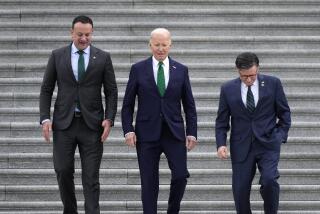Money Supply Expands $2.1 Billion
- Share via
NEW YORK — The nation’s basic money supply shot up $2.1 billion in early May, the Federal Reserve Board reported Thursday, leaving the measure known as M1 above the Fed’s growth target.
The surge in M1 was a surprise to many analysts who had been predicting a decline in the measure of funds readily available for spending and who had been hoping that the combination of a slowdown in money growth and a sluggish economy would persuade the Federal Reserve to push interest rates lower.
Fed policy-makers are scheduled to consider strategy at a meeting Tuesday in Washington, and predictions have been rampant in financial markets that there would be a cut in the discount rate--the interest on Fed loans to banking institutions--before that session.
The discount rate has stood at 8% since last December.
David Jones, an economist at the government securities firm Aubrey G. Lanston & Co., said that, with M1 still growing faster than the Fed would like and with Congress yet to complete action on reducing the size of the deficit, “the Fed might delay any easing move somewhat.”
But Jones said he still believed it inevitable that the Fed will accommodate lower interest rates because of continued signs of sluggish economic growth.
“The markets are very edgy at the moment, waiting for the Fed to drop the shoe,” said Jeffrey Leeds, an economist at Chemical Bank. “The odds slightly favor a cut in the discount rate in the next several weeks.”
The rise in M1 in early May was especially disappointing to financial economists because it reversed a slowdown in money supply growth that began in April.
The Fed reported that M1 growth was a moderate $2.9 billion in April, that a broader measure known as M2 fell $1.6 billion last month and that an even broader measure, M3, rose $1.8 billion. M1 is reported weekly, while M2 and M3 are reported monthly.
The Fed said M1 rose to a seasonally adjusted $577.6 billion in the week ended May 6 from a revised $575.5 billion in the previous week. The previous week’s figure originally was reported as $575.2 billion.
M1 includes cash in circulation, deposits in checking accounts and non-bank travelers checks.
For the latest 13 weeks, M1 averaged $573 billion, a 10% rate of gain from the previous 13 weeks.
The Fed, which tries to provide enough money to keep the economy growing without reviving higher inflation, has said it would like to see M1 grow between 4% and 7% from the fourth quarter of 1984 through the fourth quarter of 1985.
M1 rose to an average $575 billion in April from $572.1 billion in March.
M2, which includes M1 and adds to it such things as savings accounts and deposits in individual money-market mutual funds, fell to $2.427 trillion in April from $2.4286 trillion in March.
M3, which includes M2 and less liquid accounts, such as 90-day bank certificates of deposit in excess of $100,000, rose in April to $3.0575 trillion from $3.0557 trillion.
Analysts said the rise in M1 in early May could have reflected income tax refund payments by the government and the monthly payment of Social Security benefits. The drop in M2, the analysts said, may have reflected income tax payments in April made with withdrawals from money-market accounts.
In separate reports:
- The Federal Reserve Bank of New York said commercial and industrial loans at major New York City banks rose $499 million in the week ended May 8, compared to a gain of $722 million a week earlier. Commercial paper--short-term corporate IOUs--outstanding nationwide rose $1.22 billion in the week ended May 8 after rising $1.75 billion in the previous week.
- The Fed said the federal funds rate, the interest rate on overnight loans between banks and a peg for many other short-term interest rates, averaged 8.14% in the week ended Wednesday, down from 8.19% in the previous week.
- The Fed estimated that borrowings from the Federal Reserve System averaged $839 million a day in the week ended Wednesday, up from $515 million in the previous week.
- Free reserves in the banking system, an indicator of surplus funds available to banks, was revised to $165 million in the two-week period ended May 8, compared to $500 million in the previous two weeks. The original estimate of free reserves was $250 million in the latest two weeks against $490 million in the previous period.
More to Read
Inside the business of entertainment
The Wide Shot brings you news, analysis and insights on everything from streaming wars to production — and what it all means for the future.
You may occasionally receive promotional content from the Los Angeles Times.










